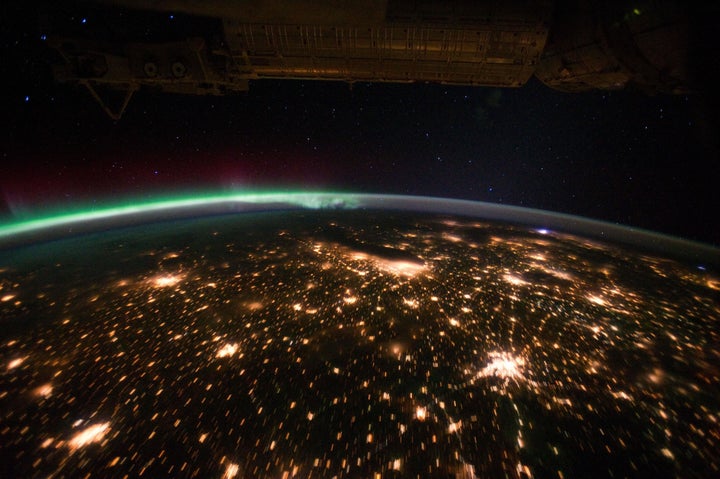
I've seen the International Space Station pass overhead several times. The first time was in fall of 2007, when there was an article in Sky and Telescope magazine encouraging people to try to spot satellites in honor of the 50th anniversary of the launch of Sputnik. I was eager to try it, so I went to the website given in the magazine and typed in my zip code. After a few seconds of calculating and the click of a button, I had a list of all of the times the space station would be visible overhead in the next week, including what direction to look in.
Since then, I've lost count of how many times I've seen the station. Most of these were from my backyard, after dark. (With the exception of one sighting from the dorm's courtyard when I was at Yale Summer Session in the summer before last.) Early evening is a good time to see satellites, because their solar arrays are still illuminated by the sun even though night has fallen on the ground, making them sparkle very brightly against the dark sky. On a good night, the space station shines brighter than any star.
The first thing you see is a bright dot of light rising above the horizon -- if you look closely, sometimes it seems to be tinged slightly yellow or even pink, unlike the blueish glow of the background stars. It's important to make sure the light is actually MOVING against the background of the fixed stars, and you aren't just seeing a star or planet you hadn't noticed before. Once you're sure that the light is moving, the way to tell you're looking at a satellite and not an airplane is to look and listen closely. If it's really a satellite, the light won't blink, and you won't hear the sound of engines, even when the light is directly overhead. The space station moves quickly -- quick enough that it circles the world every 90 minutes -- so each sighting only lasts a few minutes as the light passes from one horizon to another in a perfect arc.
Several of these sightings have been with my family, and they've enjoyed seeing the station as much as I have. My mother thought the station's dot looked like Tinkerbell, while my dad compared it to "God shining down a flashlight".
Last month, when I heard astronaut Cady Coleman speak, she recommended that all of us in the audience try to see the space station when it passed overhead. I realized that I hadn't seen a space station flyover in a while, because I'd been so busy with my internship and with getting settled at college. So, when I got home for holiday vacation, I promised myself that I would watch at least one flyover with my family before I went back to Boston.
I made plans for a few nights, but I kept either having cloudy weather or becoming busy with something else and missing the opportunity. Finally, I asked my dad to wake me up early to see the pass at 6:47 this morning, because it was my last full day with my family.
I'd never seen the station fly over in the morning before, so I wasn't sure what to expect. I got bundled up and went out to the backyard to look. The sun hadn't risen yet, but the sky was already bright enough that only the moon, the planet Mars, and a few bright stars could be seen. There was a little bit of moisture in the air, dimming those stars even more. They seemed to be half-asleep as well, peering timidly through the rose-colored sky.
After a false alarm with Mars on my dad's part, we saw the space station rising in the southwest. It wasn't as bright as when I'd seen it in the evenings -- it looked pretty much the same as the stars except that it was moving. We watched it climb higher and higher, and once we were sure it wasn't an airplane, we cheered until that bright dot became lost in the glow of the sunrise over the eastern horizon.
It may LOOK like just a dot from my backyard, but I know it's an orbital complex the size of a jumbo jet, a home and laboratory built by 16 countries working together, and a house in space that's been inhabited continuously for more than half my life. I've watched on TV as it's grown, piece-by-piece, and I've learned the names of the modules and their functions.
From my backyard, I can't see the modules. I can't see the solar arrays or the Soyuz "escape pods" docked to the station. I can't see the exercise room or the sleeping areas that I've seen in videos and pictures online. I can't see Dextre the robot or the Cupola window where so many great pictures have been taken. But I can see that little point of light in the predawn sky, one that looks as natural there as any of the planets or stars, and know that I've been lucky enough to meet ten people who've lived there.